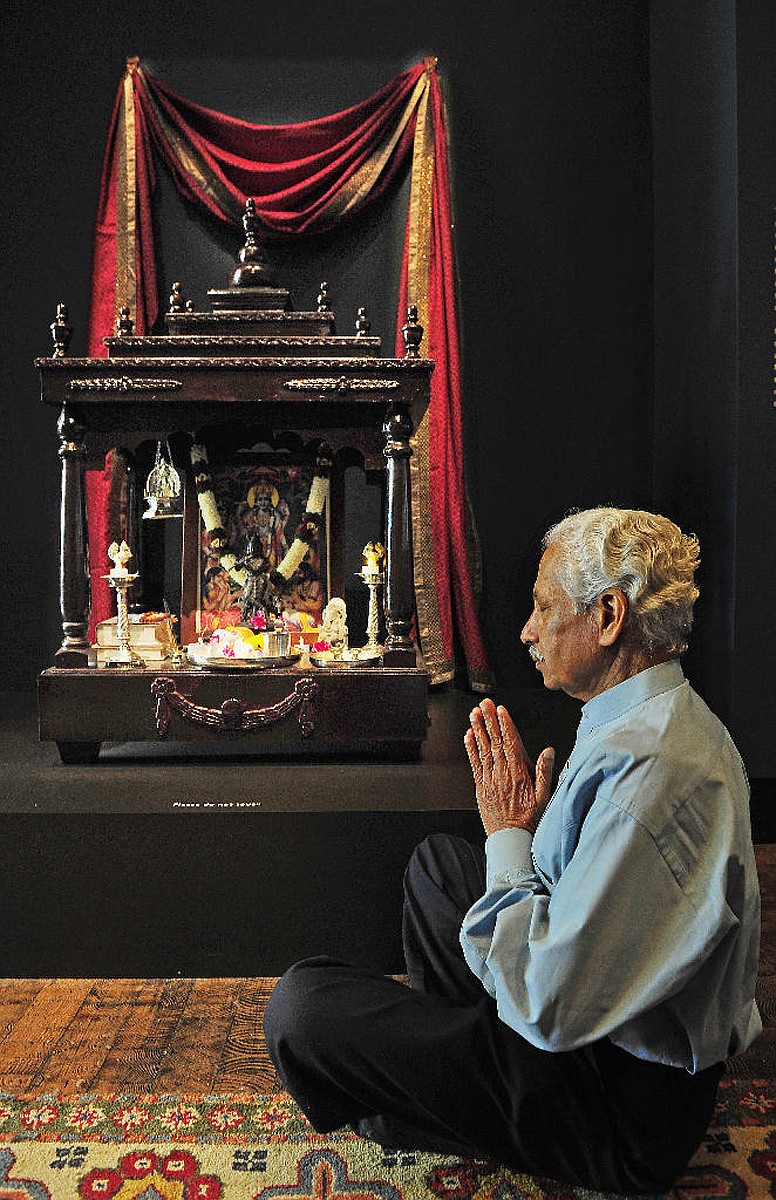NASHVILLE - The altar on C.K. Hiranya Gowda's kitchen counter is small but elegant.
There's a small sandalwood sculpture of Sri Ganesha, the elephant-headed Hindu deity, along with other small sculptures of Hanuman and Devi, two other deities.
A small oil lamp burns near the altar. Fresh flowers and fruit are set out as offerings.
Every day Gowda, a retired ear, nose and throat doctor, starts his day with prayer and meditation in front of the altar. It's a practice he learned from his parents while growing up in rural India. Every day his prayer is the same.
"I pray that God gives me the strength to do the best I can do," Gowda said.
The Vishnu exhibit at the Frist Center for the Visual Arts is bringing attention to home shrines or altars. Gowda's altar is one of five Nashville-area Hindu home shrines featured, and it's on display till the end of May. But Hindus aren't alone in their practice: Buddhists, Catholics and even a Nashville Lutheran use them for worship.
The exhibit gives local Hindus a chance to give their neighbors a glimpse into the day-to-day practice of their religion, Gowda said.
"It's a gift to everyone," he said.
Ann Taylor, curator of interpretation at the Frist, helped organize the home shrine display. She has been impressed by how local Hindus make space for their faith despite the hectic pace of modern life.
"They don't make worship a big deal," she said. "It is part of their day-to-day life."
Personal shrines aren't limited to the home, said Bill Harman, professor of religion and philosophy at the University of Tennessee at Chattanooga.
Harman said shrines often are set up at workplaces. He has seen them in restaurants and even in taxi cabs. He said the shrines often include photos of spiritual teachers - Gowda's altar, for example, includes a photo of Sathya Sai Baba, a guru from India who died this week.
The shrines provide a sense of identity for families, Harman said. Most families will begin the day with some kind of ritual at the altars. He said that at times in India's past, worship at public temples was banned. But that didn't stop worship at home.
"The home altar is really quite critical," Harman said. "Over the centuries, it's the home altar that kept Hinduism alive."
Lutheran uses one
Eric Ryniker, a member of First Lutheran Church in downtown Nashville, set up an altar in his home several years ago. At the time, Ryniker had just started practicing a pattern of regular daily prayers known as the Divine Office. His altar started simple - a table with some prayer books on it. Now he has icons of Jesus, the Virgin Mary and two saints, along with his Bible and a photo of his daughter.
He said that having an altar helps him take his mind off the worries and distractions of life and allows him to focus on his prayers.
"When I sit there before the icons and pray the ancient prayers of the church, not only am I free from the distractions and occupations of my daily life, but it is almost as though I am stepping outside of the world," he said.
While home shrines are common among Catholics, Ryniker said that some of his fellow Protestants are uncomfortable with them because of the biblical injunction against graven images.
He said that he doesn't worship the icons that are part of his shrine. And he points out that an early church gathering known as the Seventh Ecumenical Council - held in in the 8th century - approved of icons.
"Because of the incarnation, they said it was OK to have earthly things as a part of spiritual life," he said.
'My silent space'
Lisa Ernst, who teaches Buddhist meditation in Nashville, also has a home altar, with a Buddha and an incense burner on it. For her, it is a reminder that mediation is an important part of her life.
"It is like I am honoring the practice by setting aside that space," she said. "There is a pragmatic side to it: You are saying this is my silent space."
Gowda credits his daily rituals and prayers for helping him keep an even keel during his career as a doctor. He specialized in treating cancer patients, which often involved long surgeries, requiring him to keep his focus for hours at a time.
Sometimes he would include his patients in his daily prayers.
He also said the altar reminds him that spiritual peace matters more than material rewards. As a doctor, he said, he often was tempted to buy a bigger house or fancier cars as signs of his success. None of that matters when we die, he said.
"At the end, nobody can take anything with them," he said. "God said, come along. If you bring anything with you, you are too heavy for me."
